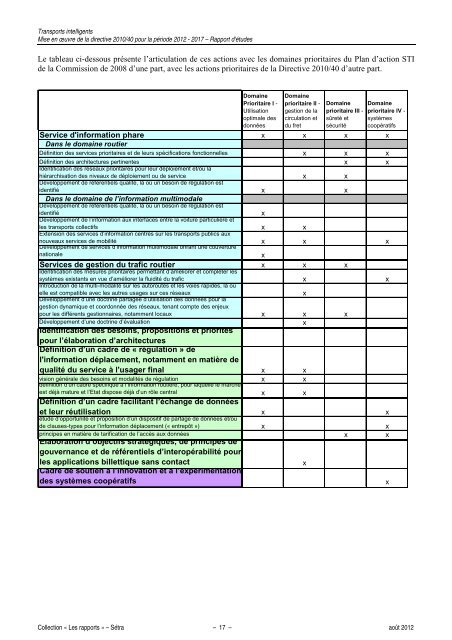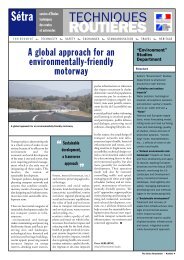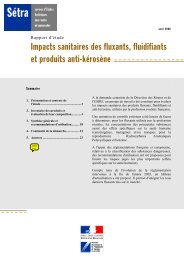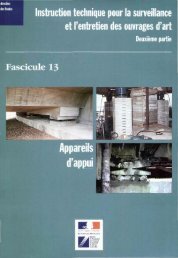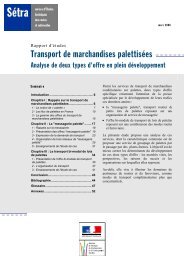Transports intelligents Mise en Åuvre de la directive 2010/40=
Transports intelligents Mise en Åuvre de la directive 2010/40=
Transports intelligents Mise en Åuvre de la directive 2010/40=
Create successful ePaper yourself
Turn your PDF publications into a flip-book with our unique Google optimized e-Paper software.
<strong>Transports</strong> <strong>intellig<strong>en</strong>ts</strong><strong>Mise</strong> <strong>en</strong> œuvre <strong>de</strong> <strong>la</strong> <strong>directive</strong> <strong>2010</strong>/40 pour <strong>la</strong> pério<strong>de</strong> 2012 - 2017 – Rapport d'étu<strong>de</strong>sLe tableau ci-<strong>de</strong>ssous prés<strong>en</strong>te l’articu<strong>la</strong>tion <strong>de</strong> ces actions avec les domaines prioritaires du P<strong>la</strong>n d’action STI<strong>de</strong> <strong>la</strong> Commission <strong>de</strong> 2008 d’une part, avec les actions prioritaires <strong>de</strong> <strong>la</strong> Directive <strong>2010</strong>/40 d’autre part.DomainePrioritaire I -Utilisationoptimale <strong>de</strong>sdonnéesDomaineprioritaire II -gestion <strong>de</strong> <strong>la</strong>circu<strong>la</strong>tion etdu fretDomaineprioritaire III -sûreté etsécuritéDomaineprioritaire IV -systèmescoopératifsService d'information phare x x x xDans le domaine routierDéfinition <strong>de</strong>s services prioritaires et <strong>de</strong> leurs spécifications fonctionnelles x x xDéfinition <strong>de</strong>s architectures pertin<strong>en</strong>tes x xId<strong>en</strong>tification <strong>de</strong>s réseaux prioritaires pour leur déploiem<strong>en</strong>t et/ou <strong>la</strong>hiérarchisation <strong>de</strong>s niveaux <strong>de</strong> déploiem<strong>en</strong>t ou <strong>de</strong> service x xDéveloppem<strong>en</strong>t <strong>de</strong> référ<strong>en</strong>tiels qualité, là où un besoin <strong>de</strong> régu<strong>la</strong>tion estid<strong>en</strong>tifié x xDans le domaine <strong>de</strong> l’information multimodaleDéveloppem<strong>en</strong>t <strong>de</strong> référ<strong>en</strong>tiels qualité, là où un besoin <strong>de</strong> régu<strong>la</strong>tion estid<strong>en</strong>tifiéxDéveloppem<strong>en</strong>t <strong>de</strong> l’information aux interfaces <strong>en</strong>tre <strong>la</strong> voiture particulière etles transports collectifs x xExt<strong>en</strong>sion <strong>de</strong>s services d’information c<strong>en</strong>trés sur les transports publics auxnouveaux services <strong>de</strong> mobilitéDéveloppem<strong>en</strong>t <strong>de</strong> services d information multimodale offrant une couverturex x xnationalexServices <strong>de</strong> gestion du trafic routier x x xId<strong>en</strong>tification <strong>de</strong>s mesures prioritaires permettant d’améliorer et compléter lessystèmes existants <strong>en</strong> vue d’améliorer <strong>la</strong> fluidité du trafic x xIntroduction <strong>de</strong> <strong>la</strong> multi-modalité sur les autoroutes et les voies rapi<strong>de</strong>s, là oùelle est compatible avec les autres usages sur ces réseauxDéveloppem<strong>en</strong>t d’une doctrine partagée d’utilisation <strong>de</strong>s données pour <strong>la</strong>gestion dynamique et coordonnée <strong>de</strong>s réseaux, t<strong>en</strong>ant compte <strong>de</strong>s <strong>en</strong>jeuxpour les différ<strong>en</strong>ts gestionnaires, notamm<strong>en</strong>t locaux x x xDéveloppem<strong>en</strong>t d’une doctrine d’évaluationxId<strong>en</strong>tification <strong>de</strong>s besoins, propositions et prioritéspour l’é<strong>la</strong>boration d’architecturesDéfinition d’un cadre <strong>de</strong> « régu<strong>la</strong>tion » <strong>de</strong>l'information dép<strong>la</strong>cem<strong>en</strong>t, notamm<strong>en</strong>t <strong>en</strong> matière <strong>de</strong>qualité du service à l'usager final x xvision générale <strong>de</strong>s besoins et modalités <strong>de</strong> régu<strong>la</strong>tiondéfinition dun cadre spécifique à l information routière, pour <strong>la</strong>quelle le marchéx xest déjà mature et l’Etat dispose déjà d’un rôle c<strong>en</strong>tral x xDéfinition d’un cadre facilitant l’échange <strong>de</strong> donnéeset leur réutilisation x xétu<strong>de</strong> d’opportunité et proposition d’un dispositif <strong>de</strong> partage <strong>de</strong> données et/ou<strong>de</strong> c<strong>la</strong>uses-types pour l’information dép<strong>la</strong>cem<strong>en</strong>t (« <strong>en</strong>trepôt ») x xprincipes <strong>en</strong> matière <strong>de</strong> tarification <strong>de</strong> l’accès aux donnéesE<strong>la</strong>boration d’objectifs stratégiques, <strong>de</strong> principes <strong>de</strong>x xgouvernance et <strong>de</strong> référ<strong>en</strong>tiels d’interopérabilité pourles applications billettique sans contactxCadre <strong>de</strong> souti<strong>en</strong> à l’innovation et à l’expérim<strong>en</strong>tation<strong>de</strong>s systèmes coopératifsxxCollection « Les rapports » – Sétra – 17 – août 2012


